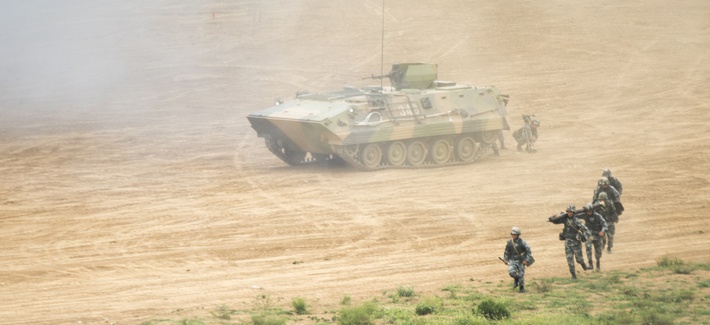But the PLA will still have more modern armored brigades than the United States.
 The People’s Liberation Army might miss modernization targets scheduled for next year, according to China’s recently published Defense White Paper.
The People’s Liberation Army might miss modernization targets scheduled for next year, according to China’s recently published Defense White Paper.
The PLA’s modernization schedule is more than symbolically tied to President Xi Jinping’s goals for the “Two Centenaries” (两个一百年). (The 2021 centenary marks the 100th anniversary of the Party’s founding; the second, in 2049, will mark the hundredth birthday of the People’s Republic of China itself.) A more capable PLA is a fundamental part of Xi’s “China Dream” (中国梦), a wide-ranging development and modernization ambition for the Chinese nation.
By next year — a deadline first laid out publicly in the 2008 Defense White Paper — the PLA is meant to have achieved basic mechanization (机械化) and made progress towards informationization (信息化). The PLA has never made public what exactly it means by either term, but the former is broadly understood to address modernizing equipment inventories, while the latter addresses the widespread adoption of digital systems in a networked environment. Taken together, they show how the PLAhas been racing to catch up with other major militaries, particularly the United States, in equipment and operational prowess.
In 2017, Xi appeared to announce that the PLA had already achieved mechanization and had made rapid progress towards informationization. Yet the authors of the white paper write that the PLA has achieved good progress, but “has yet to complete the task of mechanization, and is in urgent need of improving its informationization.” In fact, an examination of known information suggests that, particularly with regard to mechanization, Xi’s rhetorical flourish appears overly optimistic and the white paper’s caution perhaps overly pessimistic.
The PLA Army proper — that is, the ground forces — remains the service most likely to fail to meet the 2020 objectives. The most recent reorganization has shrunk the Army to fewer than one million personnel, still twice as many active-duty troops as the U.S. Army. Equipping such a force with modern equipment is an enormous undertaking. It is an even greater challenge given that the navy, air force, and rocket forces are receiving priority over the army for their own ambitious programs.
While the Army has ambitions to standardize its equipment across its newly restructured combined arms brigades, with heavy, medium, and light roles redolent of the U.S. brigade combat team structure, many formations still depend on older platforms and systems. This “partial mechanization” of the army has long been seen as a major complication in the PLA’s pursuit of informationization.
Related podcast:
The Army has about 5,800 main battle tanks in service, according to the IISS Military Balance+ database but only around 60% are based on relatively modern designs such as the ZTZ-96 and ZTZ-99. Around 2,000 are based on the obsolescent ZTZ-59, a license-built version of the Soviet T-54. Only one or maybe two brigades currently operate the Type-15 (ZTQ-15) light tank mentioned by the white paper. For other armored vehicles, the picture is worse: Only about 20 of the roughly 50 heavy and medium combined arms brigades (excluding amphibious formations) are currently equipped with the latest tracked (ZBD-04/-04A) or wheeled (ZBL-08) infantry fighting vehicles.
In short, replacing the PLA Army’s older vehicles – presumably a key component of true mechanization – would require thousands of new armored vehicles and artillery pieces over the next two years. This is highly unlikely, even if army modernization received a higher priority. Chances are better that a bare majority of the Army’s armored vehicles, artillery and air-defense systems will be modern by 2020.
While such a result might be less politically palatable than full modernization, it is important to remember that even a partially modernized PLA Army still represents an impressive capability. Even the 20 brigades that operate the ZBD-04 and ZBL-08 already outnumber the active duty U.S. Army’s 17 Armored and Stryker Brigade Combat Teams. Meanwhile, China’s neighbors, such as India, Russia and Taiwan, are all have their own problems of ground-forces modernization.
Given that the PLA Navy and PLA Air Force in particular are much further ahead than the army in terms of equipment modernization, the 2020 deadlines may represent more of a presentational concern than a practical one for the PLA.
No comments:
Post a Comment